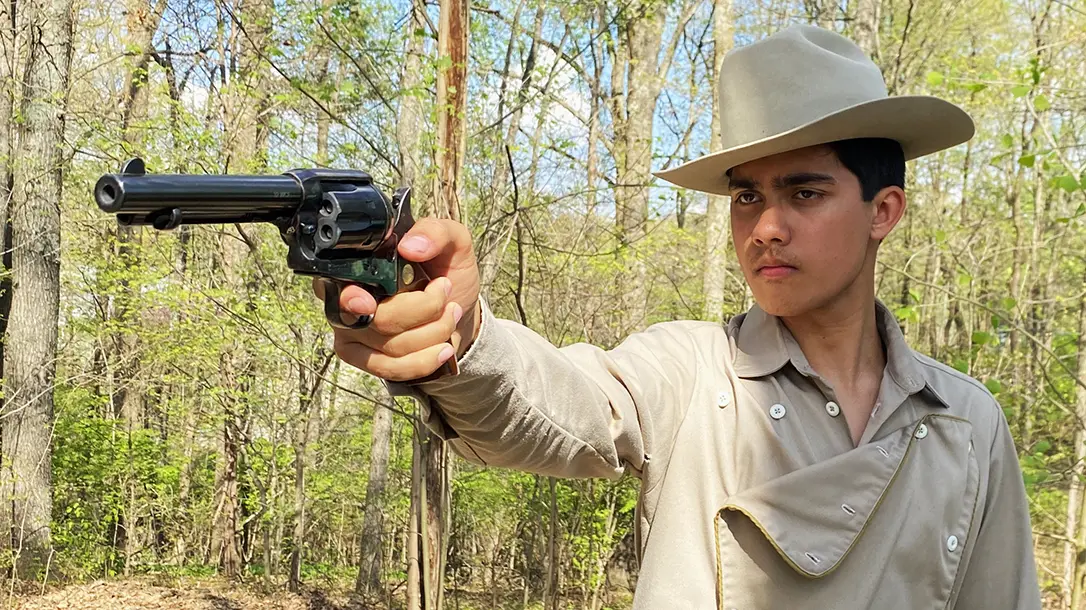Cimarron Firearms Company once again has .32-20 Model P revolvers in stock. This news will excite SASS purists and the owners of vintage 1873 and 1892 Winchester, 1894 Marlin, and Remington rolling block rifles who want to pair a matching caliber handgun with them in the pragmatic frontier style more than the typical Cowboy Action shooter; but, like a comet, it’s newsworthy whether you care or not, because it doesn’t happen often or last long.
Cimarron Firearms .32-20 Model P
These days, .32-20 guns don’t get shot all that much and that’s a shame, because it’s a classic Old West caliber that’s no more intimidating to new shooters than a .22 LR. The problem is ammunition availability. Because there’s minimal demand for factory ammunition, new production runs are limited and expensive, in some cases almost $2 a round. Fortunately, .32-20 is not difficult or costly to handload as long as one treats the delicate case necks with care to avoid crushing them and ruining the brass. A .32-20 enthusiast almost needs to be a handloader. I say almost because Black Hills Ammunition makes a nice 115-grain LFP (lead flat point) bullet load that is retailing at Brownells.com for just under a dollar a round. That’s about what you would pay for factory .45 Colt.
Winchester introduced the .32-20 for its Model 1873 in 1882. Rare and esoteric as shooting .32-20 seems today, it was quite popular for both rifles and handguns for decades, peaking in the 1920s, and gradually declining up to World War II. It proved an excellent small-game getter, launching a 115-grain bullet at around 1,100 fps with a 20-grain charge of black powder. The small bullet ruined less meat than larger calibers, had minimal recoil, and was economical to shoot.
Advertisement — Continue Reading Below
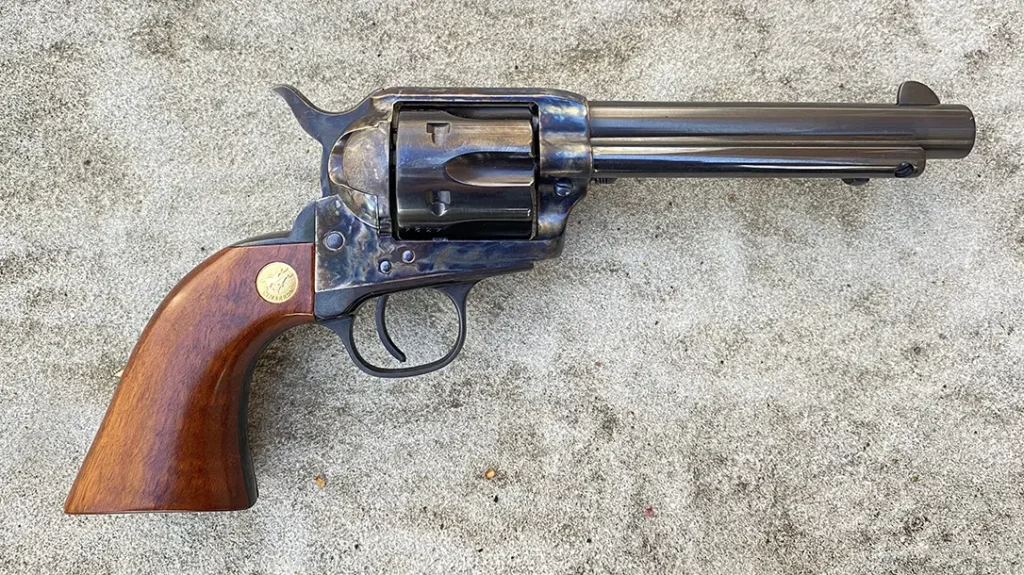
Cowboy Calibers
Among Cowboy Action shooters today, the most popular calibers are .45 Colt, .44-40 and .38 Special. Modern competitors can get both rifles and handguns in these calibers. That was not the case with .45 Colt and .38 Special in olden times. Straight-walled pistol cartridges, especially black powder ones, didn’t lend themselves well to lever-action repeating long guns. Winchester Centerfire (WCF) cartridges used brass cases with a taper for easier feeding and extraction.
Historically, when it came to rifle/pistol dual chamberings, the Model 1873 Winchester rifle led the way and Colt’s Model 1873 Single Action Army pistol followed. Of the at least 30 calibers that pistol was chambered in, the powerful military .45 Colt was by far the most popular; but the second, third and fourth most popular chamberings were all Winchester’s. Production records indicate 71,932 First Generation 1873 Colts were chambered in.44-40 (44 WCF), 50,520 in .38-40 (38 WCF) and 29,812 in .32-20 (32 WCF).
Advertisement — Continue Reading Below
Most interesting to me is the way consumer demand changed over time. Colt began chambering the .32-20 in 1884. By 1905, .32-20 had become the highest selling caliber for the big Colt six shooter. This seems to suggest a shift away from combat calibers once the “Wild West” was tamed. If small-game hunting was more important than fighting Indians and bandits in your firearm selection criteria, the .32-20 was the better option.
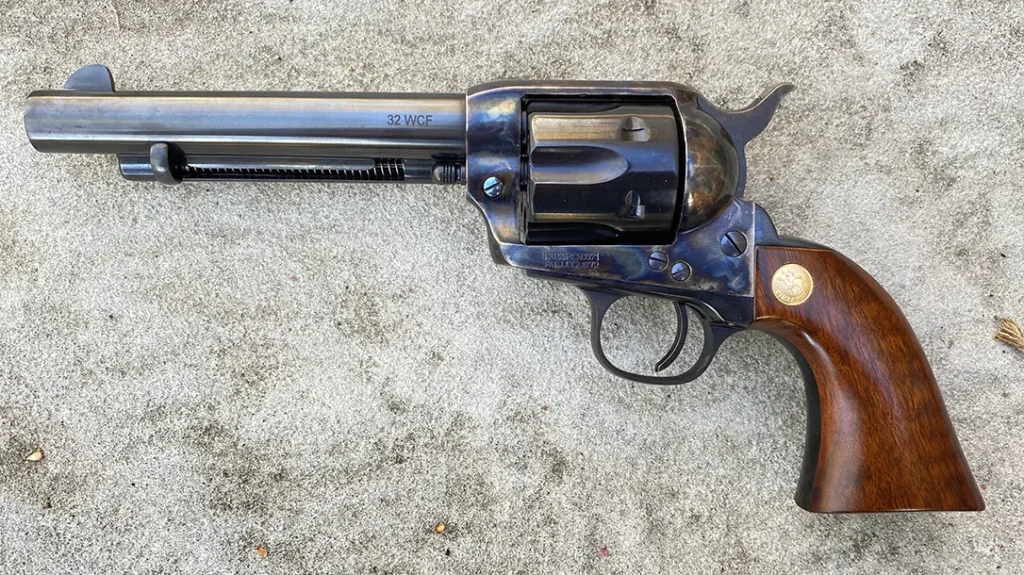
Modern Sixgun Enhancements
Cimarron’s .32-20 Model P is one of their Uberti-made guns where the firing pin only protrudes through the frame when the trigger is depressed, thus making it safe to carry with a cartridge under the hammer. Mechanically it’s quite clever, but I’d still advise keeping that chamber under the hammer empty just in case and because it’s a good safety habit.
Advertisement — Continue Reading Below
Cimarron’s always been really good at preserving the historic esthetic of their reproductions. You’ll find the cylinder is serial numbered to the frame and the Colt’s patent dates are nicely rendered. The barrel is laser etched “32 WCF” on the side, and on top where the usual “Colt’s Patent Firearms, etc., etc,” would be on a real Colt, Cimarron roll engraved the required importer’s information in a convincing, two line, period manner. The sights on the pistol are the modern, larger type that are much easier to see. Rather than the old fashioned thin from front sight blade and “U” rear notch, this gun had a 0.090-inch thick rectangular front sight and 0.115-inch rear notch. At arm’s length, they create an easy to see sight picture with half the thickness of the front blade open on each side while it sits in the rear notch.
Factory .32-20 ammunition suitable for handguns is made by Black Hills Ammunition, Winchester, Remington, HSM and Ventura Heritage. Remember that there are some much hotter loads from Remington, Jamison and Buffalo Bore, and possibly others, that are only for rifles. Don’t mix them up. The .32-20 is very sensitive to the powder burn rate and what shoots accurately in a rifle may well be all over the target when fired from a pistol.
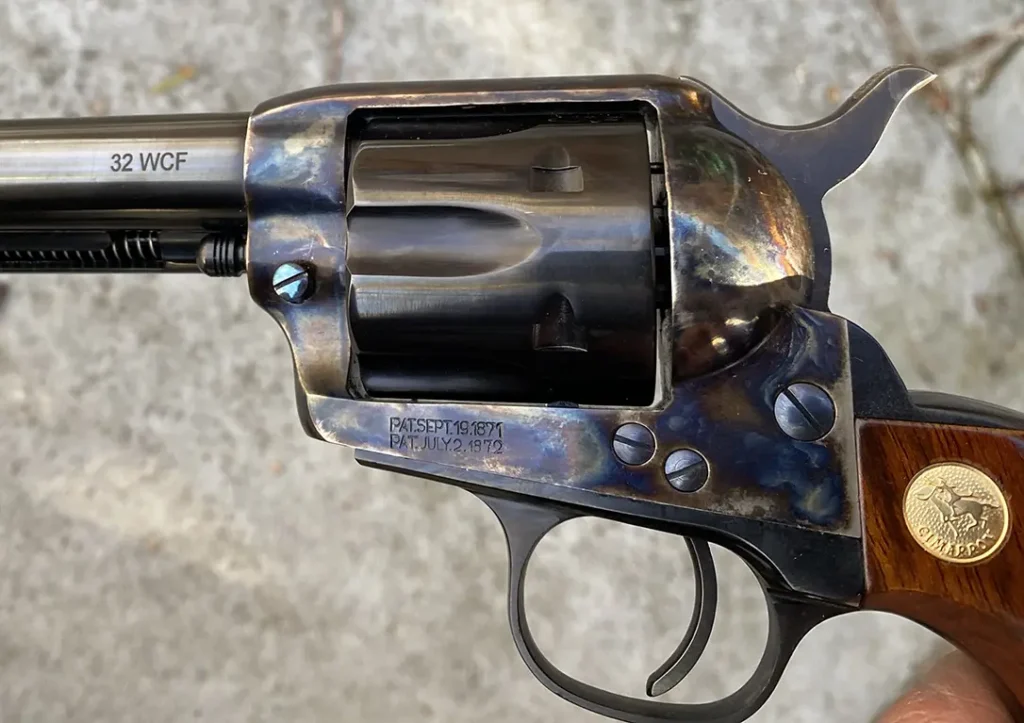
Advertisement — Continue Reading Below
Loading the .32-20
New brass cases for handloading are available most economically from Starline Brass for about $34 per bag of 100. Double-cavity 115- and 118-grain bullet molds are available from Lyman (#311008) and Saeco (#322), respectively. It is not uncommon for vintage rifles and pistols to vary in bore diameter. If you have an old gun that’s oversize, go with the Saeco mold because it casts larger (.313-inch diameter) bullets. You can size a bullet down, but you can’t size it up.
I measured the cylinder’s chamber mouths at between 0.317- and 0.318-inch. Slugging the bore revealed a groove diameter of 0.311-inch and a land diameter of 0.305-inch. The only factory ammo I could obtain for testing was from Black Hills. Pulling the bullet, I found the diameter to be 0.312-inch. Everything looked like it should work together well, so I took the pistol to the range for some accuracy testing.
Shooting from the bench with the aid of a Caldwell Shooting Supplies Pistolero rest, I fired five-shot groups at 25 yards. The trigger pull felt light and crisp, requiring from 2.5 to 2.75 pounds of force. With its thicker barrel and cylinder walls, this pistol weighs a hefty 42.4 ounces. Recoil was negligible. Groups averaged 2.79 inches and were consistently 1.5 inches right, and 7.5 inches below, the point of aim.
Advertisement — Continue Reading Below
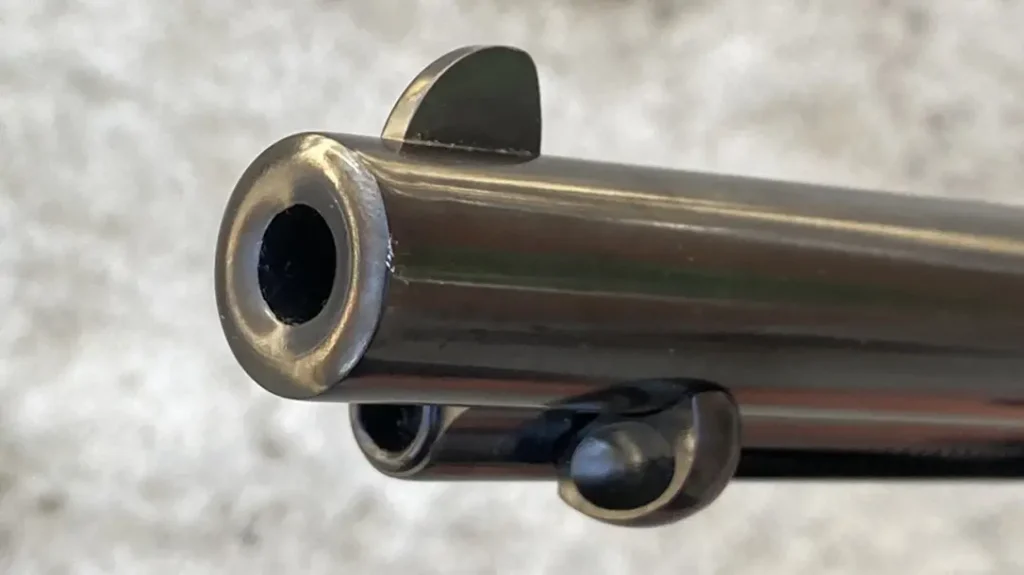
Downrange Characteristics
The .32-20 is a much flatter shooting round than its big brothers, so the expectation is that you will file down the front sight to match it up to the point of impact with your preferred load at your preferred distance. Windage corrections with fixed-sight pistols are a bit harder to correct, and I don’t think I would bother with a variance of only 1.5 inches at 25 yards; that’s easily within my Kentucky Windage capabilities. Again, test out other ammunition before you start thinking about sighting adjustments; you may not need what you initially think you do.
After shooting four groups, an examination of my target board revealed I’d piled all 20 shots into cluster measuring only 3.13 inches across. That’s very good accuracy. With handloads I suspect I could cut the groups in half.
Advertisement — Continue Reading Below
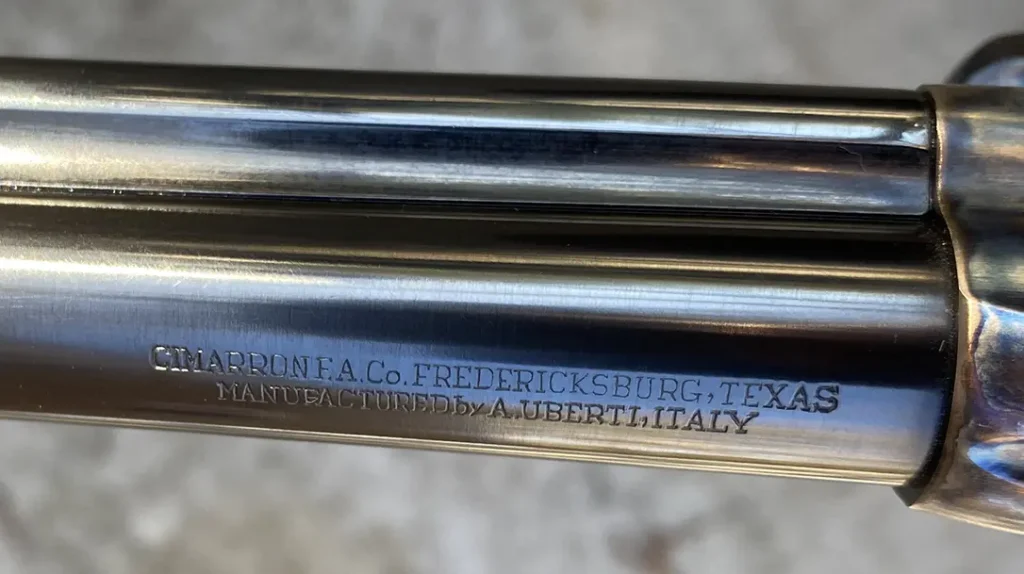
Shoot That Thing!
The .32-20 doesn’t need to be wall flower. It’s actually more economical to handload than the more popular Cowboy Action calibers. With the lead it takes you to cast one .45 Colt bullet, you can make at least two in .32-20. It requires a lot less powder too. Aside from giving you more bang for your buck, the .32-20 is ideal for beginners or the recoil sensitive. It doesn’t need downloading to be pleasant to shoot, It’s also a comparatively flat shooter, which is why steel silhouette competitors gravitated to it in years past.
To their credit, Cimarron also offers some of their reproduction 1866 and 1873 Winchester lever actions in .32-20. If my favorite daughter took an interest in the Cowboy Action game, I think I’d start her with .32-20. Having a gun, or two, in that caliber sets the stage for introducing her to small-game hunting too. Right now, there’s a coyote hanging around that she wants to kill…because she’s afraid it will eat her cat.
Advertisement — Continue Reading Below
For more info, visit cimarron-firearms.com.
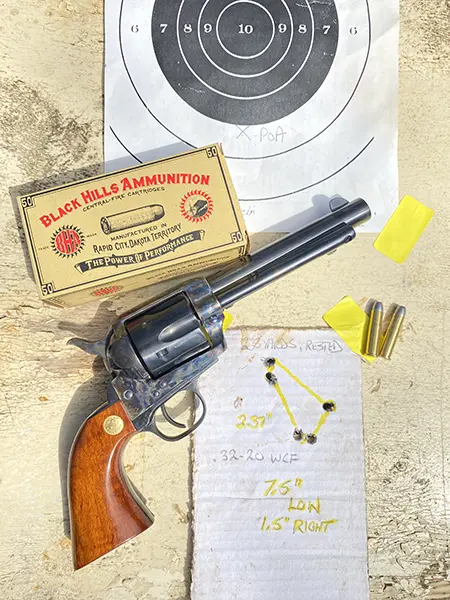
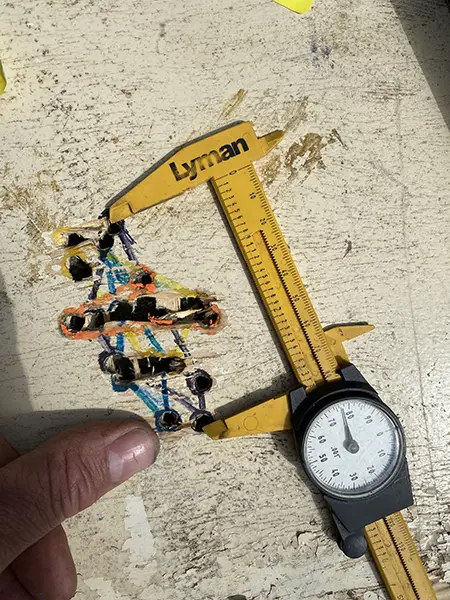
Advertisement — Continue Reading Below
Specifications: Cimarron Firearms 5.5 Inch Model P (Pre-War) .32-20
- Caliber: 32-20 WCF
- Capacity: six rounds
- Action: single
- Trigger: 2.5-2.75 pounds
- Frame: color-case hardened steel
- Barrel Length: 5.5 inches
- Grips: Pre-War model have one piece walnut stocks with Cimarron logo
- Weight: 42.4 ounces empty
- Sights: fixed
- MSRP: $714 (Online pricing suggests a street price under $600)
Performance: Cimarron Firearms 5.5 Inch Model P (Pre-War) .32-20
- Load: Black Hills Ammunition 115-grain LFP
- Velocity: 753 fps
- Best Group: 1.89 inches
Performance was tested with a series of five-shot groups fired at 25 yards from bench rest with a Competition Electronics Pro-Chrono Digital Chronograph set 15 feet from the muzzle. Bullet weight is in grains, velocity in feet-per-second and the group size in inches. LFP = Lead Flat Point bullet suitable for tubular magazine rifles.
